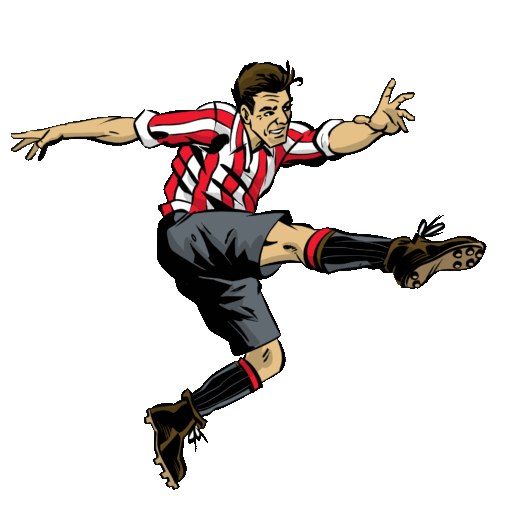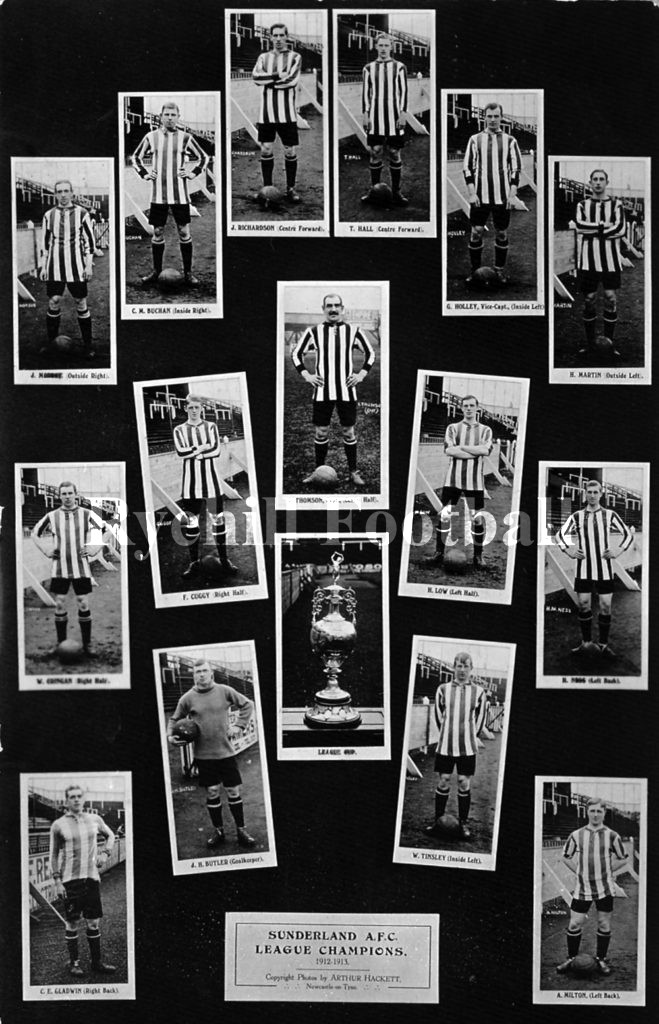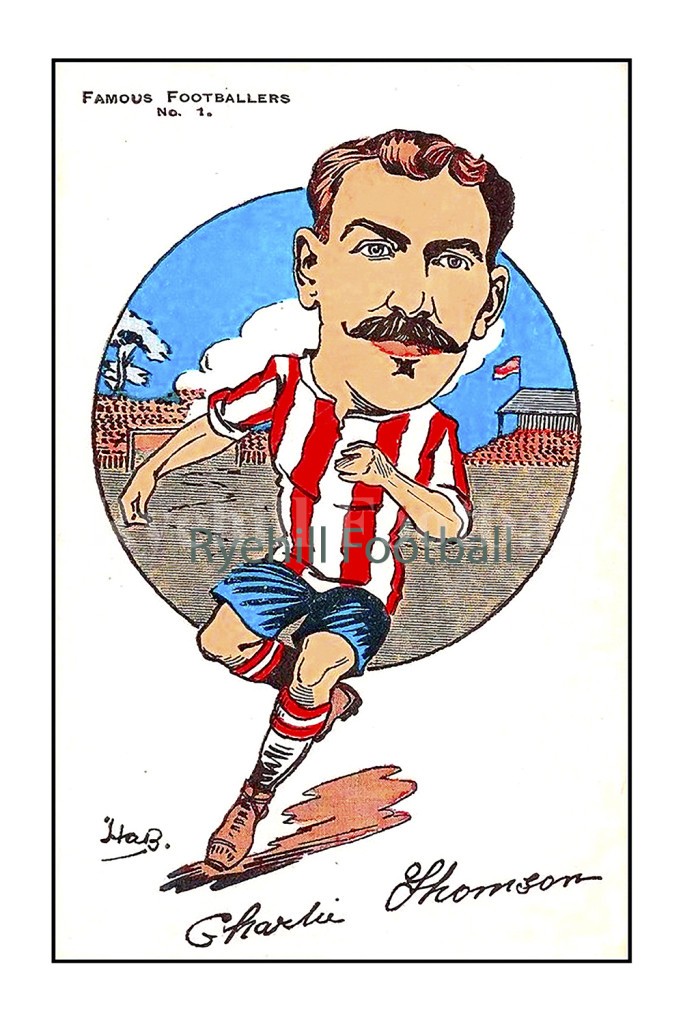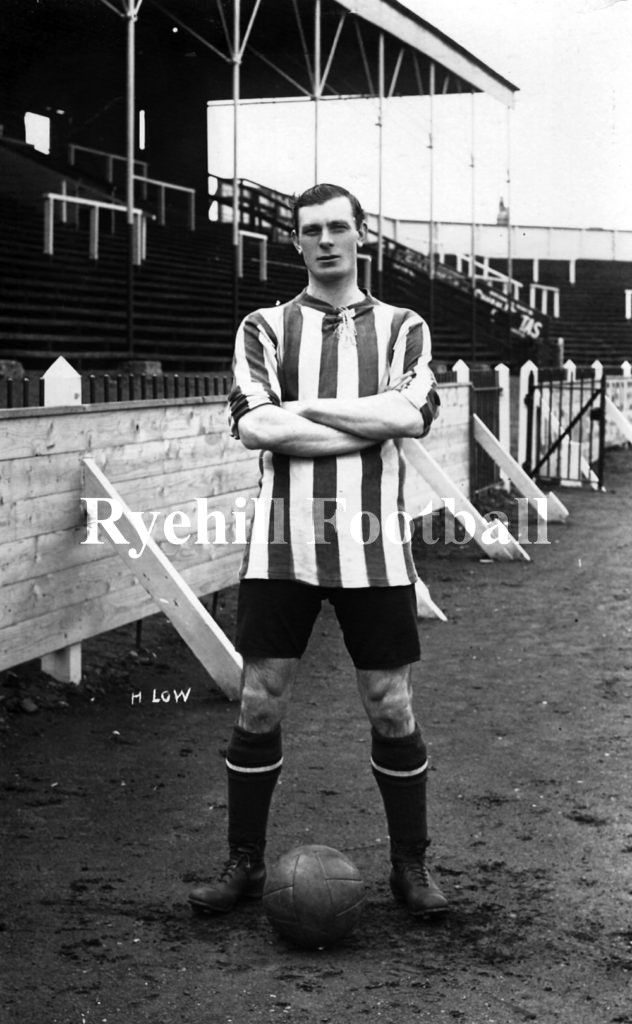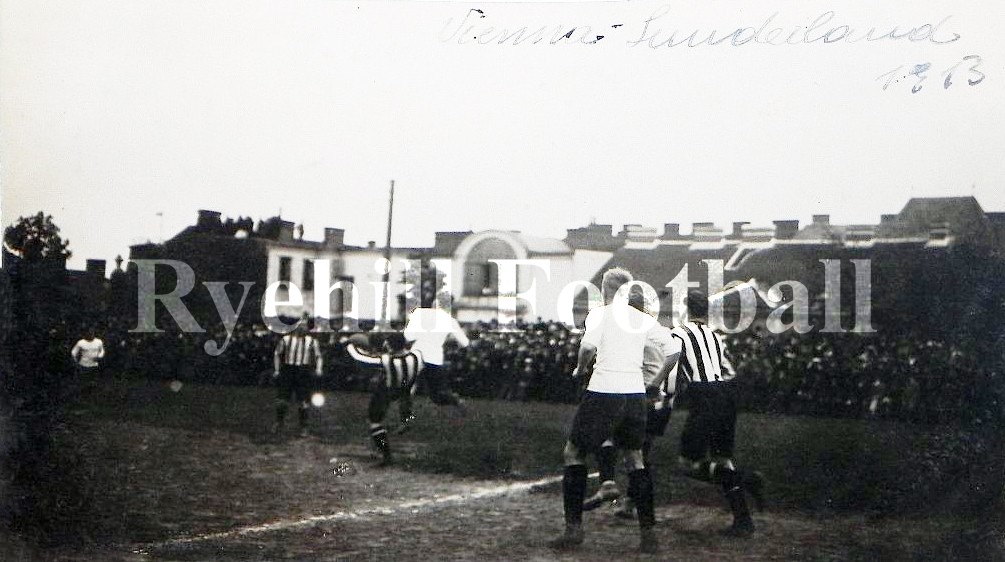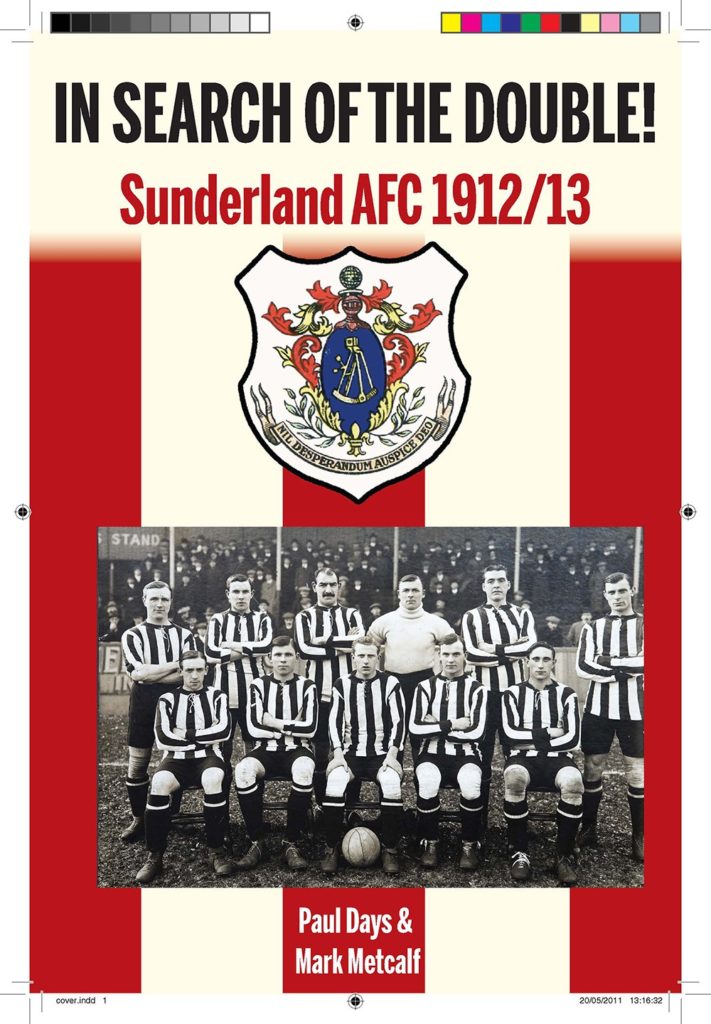Sunderland AFC 1912/13
Back row – Milton, Cringan, Thomson, Butler, Gladwin, Low
Front row – Mordue, Buchan, Hall, Holley, Martin
The passage of time does funny things to the game of association football and its legion of fans. People are inclined to forget the distant past and see a context for the game in the here and now. Today is all that matters.
For football historians the game of football is a one to be cherished because of its past. It tells them who their club once was and perhaps indicates what it could be again, given the right circumstances.
For most supporters of Sunderland AFC the past would probably be represented in the names of Gurney and Carter, undoubted Wearside footballing legends. The name of Charlie Buchan also looms large even today in the tale of a football club whose history can be cut like a knife; pre war separates from post war very easily. One demonstrates ultimate success and a continuous strive to be the best, the other doesn’t.
Although Charlie Buchan might still be a revered figure on Wearside, his team mates aren’t, and yet the 1912/13 season, which is the subject of this article, produced arguably the finest Sunderland team ever to grace the famous red and white striped shirts.
It came the closest the club has ever come to winning the double, almost became the first English football club to achieve it in the 20th century, yet the names of Albert Milton, Frank Cuggy, Jackie Mordue and the rest of Sunderland’s league champions and FA Cup finalists that season have long since been cast into the annals of the club’s history. Even the football club’s near talismanic and perhaps finest ever captain, Charlie Thomson, seemingly a man now forgotten. A team guided by Bob Kyle, Sunderland AFC’s longest serving manager in the history of the club, he too forgotten.
Although Sunderland were crowned league champions perhaps an enduring highlight, although it ultimately ended in defeat, was the now legendary FA Cup final which took place at The Crystal Palace in April of 1913, before a World’s record crowd. For the first time in the 20th Century England’s top 2 football teams contested for the most coveted domestic knockout cup competition in world football and what a tale it tells; an iconic match.
1912/13
Prior to the start of the new season the Sunderland Echo reported on Wednesday August 14th 1912 that Sunderland had made 5 new signings in the close season. One was George Hollander a right back from Edmondsley Rovers, aged 21 years. He stood 5 feet 7 inches, weighing in at 12 stone. The other new men were William Hopkins, James Richardson, John Connor and Fred Martin.
Some notable players had left.
James Gemmell returned to Scotland with Third Lanark, whilst Tommy Tait accompanied him north of the Border to Dundee. Gavin Jarvie left for Hamilton Academicals having made over 100 league and cup appearances for Sunderland and Henry Forster made the trip to West Ham United, again after more than 100 league and cup appearances. Perhaps the most high profile departure was that of Arthur Bridgett who became the Secretary-Manager for South Shields FC.
Season ticket prices had been announced. They would be 15s for the shilling stand; £1 1s for the 1/6d stand and £1 11s 6d for the vice president enclosure
Since the close of the 1911/12 season there has been one change in the laws governing the game in that the goalkeeper was no longer permitted to use his hands anywhere within his own half of the field. ‘It is a change which should give forwards a better chance, and so improve the game in front of goal, where improvement is most needed.’ It was also decided that extra-time would be played if the Cup Final ended all square after 90 minutes.
Prior to the season opener the “Whites” played “The Stripes” at Roker Park in two fiercely contest fixtures. On 21 August 1912 the former defeated the latter 4 v 1. Scoreless at half time Hinds broke the deadlock after 50 minutes with further strikes from Hindmarsh and Thomson effectively sealing the game. Although Westall reduced arrears on 85 minutes Hindmarsh scored his second with 3 minutes of the game remaining.
Although there is no match report available for the second game the Sunderland Echo reported that ‘the teams were photographed as they came out’. No trace of such a picture can now be found, long lost in the annals of time.
In 1904 and 1905 both Manchester City and Newcastle United had been within a whisker of winning the elusive league and cup double. Sunderland were to become the next team to witness heartbreak as they chased this momentous achievement. The 1912/13 season was perhaps the best season the Wearsiders ever had. Again the FA Cup proved to be the Holy Grail that would disappoint.
The season started terribly, with 5 defeats and only 2 draws in the first 7 games. With 18 goals conceded relegation looked a sure bet. However an astonishing turnaround saw Sunderland not only go on to win the title but do so with record points. Add to this an FA Cup final appearance, and it was truly a season to remember.
The “A” team also started badly, with 2 defeats in the first 3 games, but like their senior counterparts would rally.
The first game of the season was at St James Park, Newcastle and in front of over 54,000 Sunderland gained a draw 1 v 1. Shepherd had given the Magpies the lead, crashing a shot home off the underside of the bar before Mordue shot past Lawrence in the black and white goal. The game was a “family affair” with the Low brothers facing each other.
Then the defeats.
A 0 v 4 reverse at Ewood Park, initially put down to the exertions against Newcastle, 2 home defeats by Derby and Blackburn, in the former game the Rams goalkeeper Scattergood was outstanding. Oldham then defeated Sunderland so capturing a North East double, having disposed of Newcastle earlier in the season. Tottenham came North and drew and a trip to London produced a 0 v 3 drubbing by Chelsea; Whittingham scoring the opener just 30 seconds before the interval.
Then the turning point.
On 12 October 1912 at Roker Park Sunderland demolished Middlesbrough 4 v 0. It was the first home victory of the season and was played in “pea soup” like fog. Sunderland remained unbeaten for the rest of October winning The Hospital Cup against Newcastle United.
Part of the reason for the upturn in fortune had been 2 astute purchases. Joe Butler from Glossop took over in goal from Anderson, and Blackpool’s Charlie Gladwin came further north. The right back weighed in at a hefty 14 stone and stood 6 ft 1in. It was rumoured that even the much respected Captain of Sunderland, Charlie Thomson was wary of Gladwin.
Mordue and Holley then started to score freely with the security of Gladwin behind them. Sunderland won 25 of the next 31 league games.
Notts County were beaten 4 v 0, Buchan scored a brace, Sunderland gained there 4rth successive win at Valley Parade, 5 v 1, Buchan scored after 7 minutes and Sunderland never looked back. For the Manchester United game at Roker, Holley was unable to play, but it didn’t stop Sunderland running out 3 v 1 victors.
This made it five wins in a row, six if you count the Hospital Cup. There was a temporary blip, with two defeats in three games. The match at Hyde Road the home of Manchester City was lost to a penalty with a Taylor goal disallowed for offside. Then Sunderland played Liverpool and a record tumbled.
The date was 7 December 1912, the score 7 v 0. It was Sunderland’s highest win since the 9 v 1 defeat of Newcastle United at St James Park in 1908 and for Charlie Buchan it was a personal triumph scoring 5 times, including a second half hat trick. Strangely the man of the match was the Livers goalkeeper Campbell who was outstanding. But for him it would have been double figures.
At Goodison Park, Sunderland completed a memorable Merseyside double winning 4 v 0. There was a sensational start to the match as Richardson slotted home in the very first minute, and from thereon in The Toffees had no answer to a rampant red and white display. The Sunderland team that day had shown two changes, including the return of Gladwin who had recovered from rheumatism “attack”.
The “greatest game” played at Roker that season was against Bolton Wanderers, with never a dull moment. The first half was a treat to watch and even though Sunderland triumphed 2 v 1, the winner was the game of football itself. Sunderland’s last gasp sickener for the visitors came from a Mordue penalty in the last minute, after Whiteside had handled in the box.
Having beaten Sheffield Wednesday at Owlerton on Xmas Day Sunderland then succumbed to The Owls at home on Boxing Day, a first home defeat since 18 September. However Sunderland consoled themselves with a 2 v 0 success over the Magpies on the 28th of December, a game in which Buchan ran riot and but for the sterling vanguard play of Wilson it would have been a bigger defeat for the black and whites.
The 4 v 1 victory on New Years Day over Woolwich Arsenal was completed without the services of George Holley, however for the visiting player Payne it was a return home. The Wearsider was The Gunners centre forward. In fact he set up the visitors’ only goal for Lewis.
The next league game at Roker was against Oldham Athletic, who for the first time left Wearside with a point. By the time Sunderland defeated Spurs at White Hart Lane they lay 4rth in the table, although Tottenham had taken the lead through Minter, from a “capital” cross by Middlemiss.
Avenging Sunderland’s earlier defeat at Stamford Bridge, Chelsea were defeated at Roker Park before The Black Cats travelled on to Teesside and registered a 2 v 0 win at Ayresome Park. In defeating Derby County at The Baseball Ground Sunderland moved to the top of the table.
The home game against Sheffield United was designated as a benefit for Sunderland stalwart Harry Low, and the 25,000 crowd was needed as he had been guaranteed £500 by the club.
Harry Low, received a benefit match
By now the FA Cup run was in full swing and whilst the season registered a first for the club; an FA Cup Final, it was a Sunderland born football administrator who had beaten the club to such an accolade.
Charles Alcock, elected to the Committee of the Football Association in 1866, played for the Wanderers in the very first FA Cup final of 1871/72, gaining a winners medal at the expense of The Royal Engineers. He also refereed the Royal Engineers v Old Etonians in 1874/75 and the 1878/79 game between Old Etonians and Clapham Rovers.
The “English Cup Final” of 1913 was contested between the 2 best sides in the country at that time. It was quite simply the game that all football followers had waited for. Generally recognised as the best Cup final since the Everton v Aston Villa “Diamond Jubilee” final in the 1896/97 season, it was estimated that in excess of 10,000 Sunderland fans made their way to The Crystal Palace.
This was Sunderlands very first FA Cup Final whilst Villa had been victorious on 4 of their previous 5 appearances. In the League the 2 sides were separated only by Sheffield Wednesday. Sunderland were top with 49 points whilst the Villa lay third on 45.
On Cup Final day there was a full league programme, with Sunderland Reserves away at table topping Darlington in the North Eastern League, in which the red and whites were 5th.
Sunderland were favourites to lift the FA Cup.
The appointed match officials were A Adams of Nottingham (referee), Harry Taylor of Altrincham (linesman) and AF Ansell from Bedfordshire (linesman). The Earl of Plymouth was in attendance and would present the trophy to the winning captain.
Sunderland’s route to the final had been arduous and eventful. The games had witnessed an abandoned match, a twice replayed tie against arch rivals Newcastle United and two games in a replayed Semi Final against Burnley.
From their first meeting with Aston Villa in April 1890, a 7 v 2 victory for Wearside, until the last on November 13 1912, Sunderland had a slight edge with 22 victories and 11 draws in 54 previous encounters. A World record crowd of 121,919 gathered for the contest, played on a soft pitch, as a result of constant rain during the week in London. Strangely the attendance records state that the crowd numbered some 120,081, but newspaper reports of the day carried the figure as nearly 2,000 higher.
The invasion of London knew no ends and Mr. Daniels, the Traffic Manager at Kings Cross station indicated that all passenger records had been broken. Many carriage windows were broken on the way to the Crystal Palace from Kings Cross and Victoria station and 2 people were trampled in the melee on arrival, and required medical attention.
Sunderland came out into sunshine and a massive roar from both the Wearside contingent, and neutrals who sided with the North East team, with captain Charlie Thomson encouraging his team mates. Thomson was everything to the Sunderland side and was in his 5th season as captain. He was an outstanding footballer.
Aston Villa won the toss, much to the delight of their fans. The game kicked off at 3.28pm, with the Sunderland side showing 3 changes from the league meeting in November, with Cuggy, Ness and Richardson replacing Cringan, Milton and Hall.
Villa had the sun and wind at their backs and made all the early running with their captain Bache instrumental in their meaningful moves. Mordue and Buchan produced some dazzling combination play and sent a shot skimming just over the Villa crossbar; Cuggy was becoming more influential as the match wore on.
However, towards the end of the first half Stephenson was fouled and the referee had no hesitation in awarding a penalty kick. Fortunately for Sunderland, Wallace put his spot kick wide of the upright.
Sunderlands centre backs were playing excellent, and as the first half came to a close the Wearsiders were in the ascendancy. Half time came and went with the score 0 v 0.
In the second half Harry Martin dribbled towards the Villa goal and looked certain to score, however the bravery of the Villa keeper Hardy kept him at bay, but at the expense of an injury. Harrop took over between the sticks as Hardy received treatment and for a while 10 man Villa had to endure a terrible battering from the Sunderland forwards. After 10 minutes of being under the cosh Hardy returned with his leg heavily strapped. With 16 minutes of normal time remaining Barber met a lovely centre and sent a header crashing into the net. Sunderland were stunned. Despite a suspicion of offside the goal was allowed to stand.
For Barber it would be his crowning moment. Born in Newcastle he would be carried from the battlefield of The Somme some 3 years later with Mustard Gas poisoning, although he later recovered.
Buchan and Mordue piled the pressure on but Sunderland just couldn’t get the breakthrough. Villa won the cup.
Inexplicably the normally reliable Charlie Thomson folded and in the second half had a running feud with Villa’s Hampton. Both were suspended the following season until the end of October. The referee Mr. Adams from Nottingham was also suspended, having allowed no less than 17 minutes for stoppage time. He retired.
Sunderland had tried valiantly but it was generally agreed that The Black Cats lost it through some poor play by the half backs. This was the closest Sunderland would ever come to achieving the double. News of the defeat reached Roker Park where the Monkwearmouth Charity Cup final between Southwick and Horden Athletic was being played. There was a deathly hush. Also on that day Wearmouth Colliery defeated Carol Street 6 v 1, a match which carried little significance at the time but would become a destined place for Sunderland as the 20th Century drew to a close.
The FA Cup Final defeat could be put down to one overwhelming emotion; nerves.
Although the FA Cup had been lost there was a league title to win and as fate would have it Sunderland travelled to Aston Villa the next week and came away with a draw that effectively ended Villa’s title hopes. An away win at Bolton Wanderers and a narrow home success against Bradford City saw Sunderland home and into the record books as English League champions.
An end of season tour to Germany, Hungary and Austria was the players reward for their endeavours.
What a season it had been for Sunderland AFC and its followers, perhaps the greatest in the club’s illustrious pre war period.
